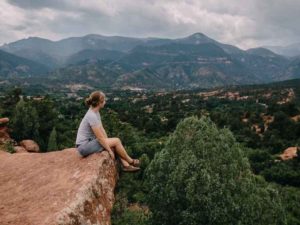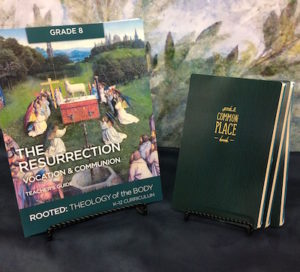
Notes from the Author: ROOTED Grades 6-8
June 25, 2018
What an exciting journey! For the last year and a half I have immersed myself in John Paul II’s Theology of the Body and have begun crafting the curriculum for Grades 6-8. After many months of waiting, the Pilot is finally here. I am so happy to be able to share it with classrooms this fall.
 Throughout this process, I’ve truly grown to love the middle school years. While it’s a difficult time of transition for our young people, it is also a really beautiful time. It is a time ripe for wonder, discovery, challenge, and adventure. These years are so precious and are a critical time for formation. As they head into their adolescent years, we want them to be sure and confident that no matter what they do or achieve, their life is a gift, and they are seen, known, loved and understood, and they are called to great things.
Throughout this process, I’ve truly grown to love the middle school years. While it’s a difficult time of transition for our young people, it is also a really beautiful time. It is a time ripe for wonder, discovery, challenge, and adventure. These years are so precious and are a critical time for formation. As they head into their adolescent years, we want them to be sure and confident that no matter what they do or achieve, their life is a gift, and they are seen, known, loved and understood, and they are called to great things.
In order to communicate the rich message of John Paul II to young people, I wanted the curriculum to be unique and stand out. I wanted it to be an experience the students (and teachers!) would remember. I wasn’t interested in offering a memorize-fill-in-the-blank-then-easily-forget style of workbook. Instead, each student has their own Commonplace Book. An unconventional size, texture, and format, this little book is a place that allows the student to work through and ponder each of the units in a structured and personalized way. In addition, it was important that the content matched the form or method by which it was taught. In other words, if we are highlighting the importance of the body, we want  the body to be involved in the learning process! While there is a time and place to sit at desks for quiet work, there is also a time and a place for getting up and moving around, embodying through various activities the themes of Theology of the Body. Think back to your own early days in school. What things do you remember the most? Usually it’s those things that were unconventional, creative, and involved your body.
the body to be involved in the learning process! While there is a time and place to sit at desks for quiet work, there is also a time and a place for getting up and moving around, embodying through various activities the themes of Theology of the Body. Think back to your own early days in school. What things do you remember the most? Usually it’s those things that were unconventional, creative, and involved your body.
 During the course of the unit, there are several “stages” that allow teacher and student to come back to the same concept, but presented in a different format (utilizing not only visual and auditory senses, but also kinesthetic senses). It is a beautiful process of discovery that slowly builds through the course of the unit, and allows the teacher to be patient with the student (and themselves), not worrying if they don’t get it the first time through. If something is left unclear in the Lesson stage, there is time to revisit it in Discussion time. Maybe a student isn’t talkative or a good reader, so perhaps it will click for them in the Experience stage, which reiterates the same theme via a game or physical activity.
During the course of the unit, there are several “stages” that allow teacher and student to come back to the same concept, but presented in a different format (utilizing not only visual and auditory senses, but also kinesthetic senses). It is a beautiful process of discovery that slowly builds through the course of the unit, and allows the teacher to be patient with the student (and themselves), not worrying if they don’t get it the first time through. If something is left unclear in the Lesson stage, there is time to revisit it in Discussion time. Maybe a student isn’t talkative or a good reader, so perhaps it will click for them in the Experience stage, which reiterates the same theme via a game or physical activity.
Assignments are given in the Beyond the Classroom section to help them remember the themes of the unit, and make connections to life in the world. A Teacher Guide is also provided in order to aid the teacher in drawing the students into the wonder and mystery of Theology of the Body. In the end, the goal is to make the experience for the teacher and student as rich and memorable as possible. This curriculum is a journey of discovery, not a list of definitions to be quickly memorized and forgotten. We desire that students and teachers truly experience the deep and powerful message of John Paul II that is so badly needed in our culture today. It is a difficult time in which we live, but
it is also an exciting time! There is so much work to be done, but there is so much hope in the hunger of the next generation for something more than what is being offered in today’s society. I’m so pleased to be able to share the Pilot material with you, and be sure to keep me in prayer as I continue writing the remaining units this coming year.
Share